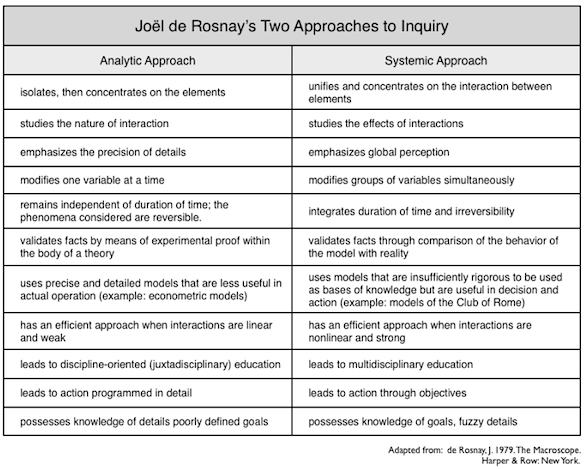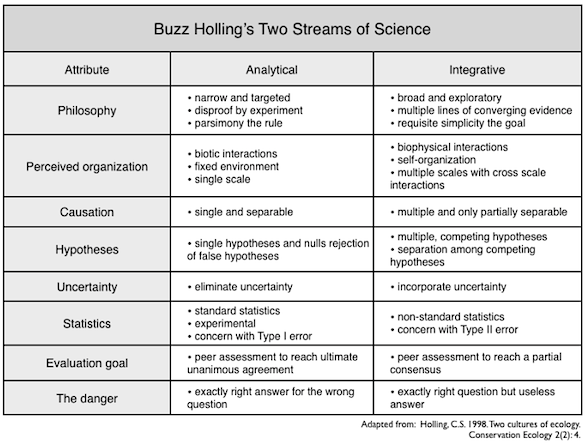
Analysis offers a science of parts, synthesis a science of the integration of parts.
These are the thumbnail-sketch definitions used by Buzz Holling to describe “two very different ways of viewing the world.” Holling’s 1998 essay “Two Cultures of Ecology” was posted to “help shape the focus” for the then-new journal Conservation Ecology, now Ecology and Society.
Here are two approaches to analysis-synthesis comparison, the first from Joël de Rosnay’s 1979 book, The Macroscope, and the second from Holling’s essay. De Rosnay cautions against an “excessively dualist” interpretation and urges that analysis and synthesis be understood as complements, neither reducible to the other. Holling compares the two cultures of biological ecology as an example of the two streams of science he describes more broadly throughout the essay.


See also:
- Bartlett, G. 2001. Systemic Thinking: A simple thinking technique for gaining systemic focus. Numerous diagrams on “analytical” versus “systemic” thinking.
- Barton, J. and T. Haslett. 2007. Analysis, synthesis, systems thinking and the scientific method: rediscovering the importance of open systems. Systems Research and Behavioral Science 24:143–155. “The paper argues that the scientific method is most usefully interpreted as a dialectic between analysis and synthesis supported by the triadic logic of C.S. Peirce, and that the role of systems thinking is to frame this dialectic.”
- Saner, M. A. 1999. Two cultures: not unique to ecology. Conservation Ecology 3(1): r2. A response to Holling’s paper.
- Umpleby, S., et al. 2012. A Report from the 2012 IFSR (International Federation for System Research) Conversation (pdf). Distinguishes between “Science I” and “Science II” and provides conceptual background for the upcoming Modes of Explanation conference.


Dear Howard
Thank you for referencing my article on analysis and synthesis.
Keep up the good work!
John
Thanks, John!
After reading about the differences between analytic and systemic analysis, by Joel de Rosnay I got the thought that right-brain dominant people would be better at synthesis, while left-brainers would excel at analysis. Balanced-brainers (left and right are equal, with neither hemisphere dominant,) would be equally good, or bad, at both forms of inquiry. I liked the divisions and thought the author did a good job of separating analysis from synthesis. Experiments on right-handed and left-handed people, or testing for right and left brainedness would be interesting in terms of finding out if my theory holds water. I enjoyed.